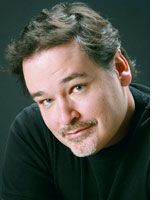 Sean O’Skea, professor of scenic design at Southern Oregon University, designed last spring’s brilliant production of “Angels in America: Millennium Approaches,” directed by Jim Edmondson. “Angels in America Part Two: Perestroika” will play Nov. 14-24 in SOU’s Main Stage Theatre. I met O’Skea in the lobby of the newly expanded Theatre Arts Building on the SOU campus.
Sean O’Skea, professor of scenic design at Southern Oregon University, designed last spring’s brilliant production of “Angels in America: Millennium Approaches,” directed by Jim Edmondson. “Angels in America Part Two: Perestroika” will play Nov. 14-24 in SOU’s Main Stage Theatre. I met O’Skea in the lobby of the newly expanded Theatre Arts Building on the SOU campus.
EH: What’s your process of designing a play?
Sean O’Skea: It’s the same with all the designers, actors and directors. We start with the text and get a sense of what the play is trying to say. Designers are always sort of subordinate to the director’s vision. There are an infinite number of possibilities of ways that a play can be interpreted, especially good, rich, meaty plays. In an ideal situation, it becomes a nice collaborative back and forth. I’ll show some imagery, and the director will respond to it, and I’ll have a second pass at it, and we’ll go through that.
It’s always different depending on the venue, where it is, the time frame and budget. It changes a lot. There are so many variables as to how you get from the idea of the set to the actual set, and only some of those have to do with your artistic vision. If you go in with your dream of what that show wants to look like, and the director has an entirely different direction, it can be heartbreaking sometimes. It’s all part of the process.
EH: How has new technology affected your designing?
SO: Everything is done in Photoshop, everything is done digitally with software. We’re modeling our scenery and then drafting off of a very accurate digital model of the theater. Our precision is going up. There are fewer opportunities for operator error. But there is a technological hurdle when it comes to the process. I spend a lot of time teaching those skills to my students. I still think hand drafting is an art and should be maintained, but that’s not how we work anymore.
I think we will see in our lifetime hydraulic floors installed in theaters, where the platforms raise up and down, and the rest of it will be light, LED screens. It’s not projections coming out of a lens, the surface itself is illuminated.
EH: Do you still make the physical models?
SO: That’s the one old-school thing that I will continue to teach, because directors love that. It’s tactile; it’s visual; they can reach in and play doll house. That’s still very much alive. What material you’re trying to represent oftentimes dictates how they’re made. I teach my students that there’s no material off limits. The only thing that I forbid them to use is anything that’s going to rot: “Please don’t use cheese in your model.”
EH: What are your favorite shows to design?
SO: It’s always best to work on a show that doesn’t have a definitive set. You want the Shakespeare, the Greek, the thing that’s very presentational in its approach — magical realism. I would call “Angels in America” magical realism. It’s not coming out of the Latin American tradition, but it certainly is magical realism. There are angels talking, some guy is walking into some woman’s dream. What we do best are the close-up magic tricks: What this person’s fever dream looks like is much more interesting than interior decoration.
My favorite kinds of scenery are ones that are changing or ones that reach out into the house. What theater should be is gathering around the campfire, telling stories, and having that 360-degree experience.